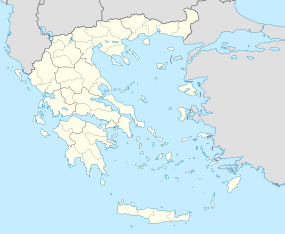Isthmia (ancient city)
| Location | Kyras Vrysi, Corinthia, Greece |
|---|---|
| Region | Corinthia |
| Coordinates | 37°54′57.3372″N 22°59′35.4084″E / 37.915927000°N 22.993169000°ECoordinates: 37°54′57.3372″N 22°59′35.4084″E / 37.915927000°N 22.993169000°E |
| Type | City |
| History | |
| Founded | 690 to 650 BC |
| Abandoned | 470 BC |
| Periods | Archaic Greek |
| Satellite of | Isthmia |
Isthmia is an ancient city located on the Isthmus of Corinth in Greece. It is well known for being home to the Isthmian Games and is also the site of major Greek monuments, such as the Temple of Isthmia that honors the Greek God, Poseidon.
The city of Isthmia is located on the main road that connected Athens and Corinth in the ancient world. This made it an easy stop for many travelers and therefore a logical geographic choice for the Panhellenic Games and monumental religious sanctuaries. Its location on the Isthmus and major ports created huge traffic through the city and established Isthmia as the hub for athletic and religious festivals; second in significance only to those at Olympia.
Stone artifacts found on the site have been dated to show that humans have inhabited Corinthia since the Neolithic Era. Small samples of pottery dating to the last era of the Bronze Age (1600-1200 BC) show that people were still living in Isthmia during this time. During the Greek Dark Ages, the population declined throughout Greece, and with it came a deterioration of material wealth in Isthmia.
As Greece moved into the Archaic period, writing, material culture, and population all increased. The people of Isthmia began constructing large stone monuments and religious sanctuaries. In the year 481 BC, the Persian Empire attempted to invade Greece. Isthmia was not a major battlefield, but its central location made it a preferred site for Greek conferences and pre–battle meetings. The Archaic-style temple at Isthmia was badly burned in a fire in 480 BC, and the Doric-style temple remains were repaired using Classical architecture style elements.
In the years 431–404 BC, Isthmia was caught in the middle of the Peloponnesian War between Athens and Sparta. A second war between the two city-states occurred in the years 395–387 BC and the archaic temple for Poseidon was burned down in 390 BC. It is unclear whether the destruction of the temple was a result of the dispute, but the lack of pottery found at the site after the fire indicates that Isthmia entered a period of decreased prosperity at this time.
...
Wikipedia

